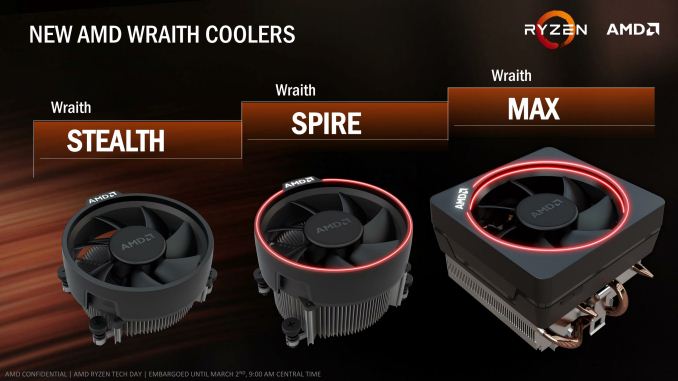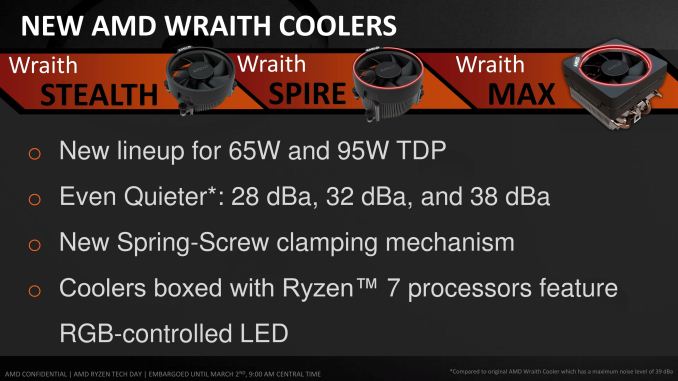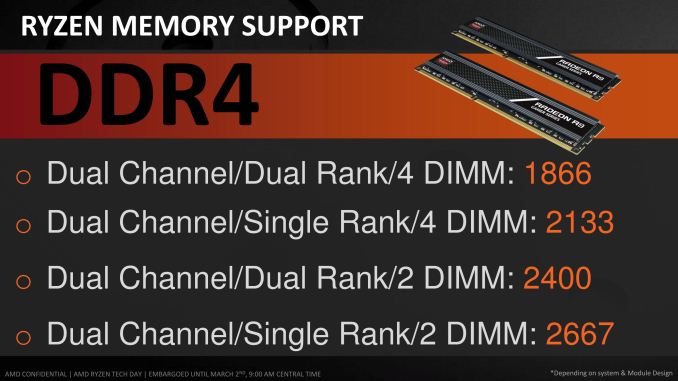The AMD Zen and Ryzen 7 Review: A Deep Dive on 1800X, 1700X and 1700
by Ian Cutress on March 2, 2017 9:00 AM ESTAMD Stock Coolers: Wraith v2
When AMD launched the Wraith cooler last year, bundled with the premium FX CPUs and highest performing APUs, it was a refreshing take on the eternal concept that the stock cooler isn’t worth the effort of using if you want any sustained performance. The Wraith, and the 125W/95W silent versions of the Wraith, were built like third party coolers, with a copper base/core, heatpipes, and a good fan. In our roundup of stock coolers, it was clear the Wraith held the top spot, easily matching $30 coolers in the market, except now it was being given away with the CPUs/APUs that needed that amount of cooling.
That was essentially a trial run for the Ryzen set of Wraith coolers. For the Ryzen 7 launch, AMD will have three models in play.
These are iterative designs on the original, with minor tweaks and aesthetic changes, but the concept is still the same – a 65W near silent design (Stealth), a 95W near silent design (Spire), and a 95W/125W premium model (Max). The 125W models come with an RGB light (which can be disabled), however AMD has stated that the premium model is currently destined for OEM and SI designs only. The other two will be bundled with the CPUs or potentially be available at retail. We have asked that we get the set in for review, to add to our Wraith numbers.
Memory Support
With every generation of CPUs, each one comes with a ‘maximum supported memory frequency’. This is typically given as a number, with the number aligning with the industry standard JEDEC sub-timings. Technically most processors will go above and beyond the memory frequency as the integrated memory controller supports a lot more; but the manufacturer only officially guarantees up to the maximum supported frequency on qualified memory kits.
The frequency, for consumer chips, is usually given as a single number no matter how many memory slots are populated. In reality when more memory modules are in play, it puts more strain on the memory controller so there is a higher potential for errors. This is why qualification is important – if the vendor has a guaranteed speed, any configuration for a qualified kit should work at that speed.
In the server market, a CPU manufacturer might list support a little differently – a supported frequency depending on how many memory modules are in play, and what type of modules. This arguably makes it very confusing when applied at a consumer level, but on a server level it is expected that OEMs can handle the varying degree of support.
For Ryzen, AMD is taking the latter approach. What we have is DDR4-2666 for the simplest configuration – one module per channel of single rank UDIMMs. This moves through to DDR4-1866 for the most strenuous configuration at two modules per channel with dual-rank UDIMMs. For our testing, we were running the memory at DDR4-2400, for lack of a fixed option, however we will have memory scaling numbers in due course. At present, ECC is not supported ECC is supported.













574 Comments
View All Comments
zangheiv - Thursday, March 2, 2017 - link
Hard to believe how a company like intel that repeatedly and knowingly engaged in illegal acts and other tactics to monopolize the market and cheat the consumers into high-prices, can still have dumb happy consumers after Ryzenlmcd - Thursday, March 2, 2017 - link
Some people like 256-bit vector ops I guess :-/ who would've guessed?Ratman6161 - Thursday, March 2, 2017 - link
Have to agree. To me, the i7-7700K seems like the better bargain right now. Then again, I'm looking at a $329 I7-6700K motherboard and CPU bundle and the 7700K isn't really all that much of an upgrade from the 6700K. But in the final analysis, after all this reading, I'm still not seeing anything that makes me want to rush out and replace my trusty old i7-2600K.Meteor2 - Friday, March 3, 2017 - link
+1. Maybe, as Rarson says above, a 4C/8T Zen might clock fast enough to challenge the 7700K. But in the workloads run at home, the 1800X does not challenge the (cheaper) 7700K.HPC and data centre are completely different and here Zen looks like it has real promise.
Meteor2 - Friday, March 3, 2017 - link
...Sadly the R5s are clocked equally low.https://www.google.co.uk/amp/wccftech.com/amd-ryze...
Limited by process, I guess.
Cooe - Sunday, February 28, 2021 - link
Again. You're an absolute idiot for thinking that the only "workloads done at home" are 1080p gaming & browsing the web.... You are so out of touch with the desktop PC market, it's almost unbelievable. Here's hoping you were able to aquire some common sense over the past 4 years.cmdrdredd - Saturday, March 4, 2017 - link
" I'm still not seeing anything that makes me want to rush out and replace my trusty old i7-2600K."I agree with you. I have an overclocked 3570k and I don't see anything that makes me feel like it's too old. I'm mostly gaming on my system when I use it heavily, otherwise it's just general internet putzing around
Jimster480 - Thursday, March 2, 2017 - link
Sorry but this is not the case.This is competing against Intel's HEDT line and not against the 7700k.
2011v3 offers more PCI-E lanes only if you buy the top end CPU (which ofc isn't noted in most places) a cheaper chip like the 5820k for example only offers like 24 lanes TOTAL. Meaning that in price comparison there is no actual comparison.
Ratman6161 - Thursday, March 2, 2017 - link
Well, whomever is trying to compete against, I7-7700K is about the top of the price range I am willing to spend. So Intel's 2011V3 lineup isn't in the cards for me either. AMD really isn't offering anything much for the mid range or regular desktop user either. In web browsing, office tasks, etc, their $499 CPU is often beaten by an i3. Now, the i3 is just as good as an i7-6900K too and in at least one test the i3 7350K is top of the charts. Why does this matter? Well, where does AMD go from here? If the i3 out performs the 1800x for office tasks, what will happen when they cut it to 4 cores to make a cheaper variant? Seems like they are set up for very expensive CPU's and for CPU's they have to sell for next to nothing. Where will their mid range come from?silverblue - Thursday, March 2, 2017 - link
Something tells me that if I decide to work on something complicated in Excel, that i3 isn't going to come anywhere near an R7. Besides, the 4- and 6-core variants may end up clocked higher, we don't know for sure yet.